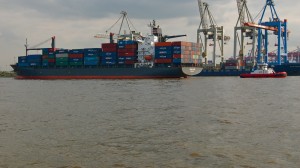
Estonia, Latvia and Lithuania saw their exports for the first quarter of 2010 grow by 17, 14 and 11 percent respectively, Eurostat reported. Photo by Hans-Jürgen Becker.
RIGA — The three Baltic countries have seen their exports pick up year on year during the first quarter of the year, a good sign for economic recovery.
During the economic crisis, all three of the countries saw their exports drop like stones forcing the manufacturing sectors in particular to lay off scores of workers. Analysts say that all three of the countries will be led out of the crisis by their predominantly Northern and Eastern European trade partners’ demand [private_supervisor]picking up and exports increasing.
In non-seasonally adjusted data, Estonia, Latvia and Lithuania saw their exports for the first quarter of 2010 grow by 17, 14 and 11 percent respectively, Eurostat reported.
Across the EU27 area, during the first four months of the year, exports grew by 16 percent overall.
Latvia and Estonia both saw their trade deficits reduce, with exports outgrowing imports. Large current account deficits were a hallmark of the “Baltic Tiger” boom years during the last decade.
Latvia’s imports decreased year on year in the first quarter by 4 percent, edging it towards a balance in trade. The country ran a trade deficit of €300 million during the period.
Estonia’s imports rose by 11 percent over the period, but their trade deficit reduced by around €100.
Largely because of the shut down of the country’s nuclear power plant and the new imperative to import gas, imports rose sharply in Lithuania, rising by 14 percent, increasing the trade deficit by around €100 million.
Growth in imports from Russia was the biggest increase for a single trading partner for the EU27 with a 35 percent jump over the year. Exports to China grew sharpest with a 48 percent rise. [/private_supervisor] [private_subscription 1 month]picking up and exports increasing.
In non-seasonally adjusted data, Estonia, Latvia and Lithuania saw their exports for the first quarter of 2010 grow by 17, 14 and 11 percent respectively, Eurostat reported.
Across the EU27 area, during the first four months of the year, exports grew by 16 percent overall.
Latvia and Estonia both saw their trade deficits reduce, with exports outgrowing imports. Large current account deficits were a hallmark of the “Baltic Tiger” boom years during the last decade.
Latvia’s imports decreased year on year in the first quarter by 4 percent, edging it towards a balance in trade. The country ran a trade deficit of €300 million during the period.
Estonia’s imports rose by 11 percent over the period, but their trade deficit reduced by around €100.
Largely because of the shut down of the country’s nuclear power plant and the new imperative to import gas, imports rose sharply in Lithuania, rising by 14 percent, increasing the trade deficit by around €100 million.
Growth in imports from Russia was the biggest increase for a single trading partner for the EU27 with a 35 percent jump over the year. Exports to China grew sharpest with a 48 percent rise. [/private_subscription 1 month] [private_subscription 4 months]picking up and exports increasing.
In non-seasonally adjusted data, Estonia, Latvia and Lithuania saw their exports for the first quarter of 2010 grow by 17, 14 and 11 percent respectively, Eurostat reported.
Across the EU27 area, during the first four months of the year, exports grew by 16 percent overall.
Latvia and Estonia both saw their trade deficits reduce, with exports outgrowing imports. Large current account deficits were a hallmark of the “Baltic Tiger” boom years during the last decade.
Latvia’s imports decreased year on year in the first quarter by 4 percent, edging it towards a balance in trade. The country ran a trade deficit of €300 million during the period.
Estonia’s imports rose by 11 percent over the period, but their trade deficit reduced by around €100.
Largely because of the shut down of the country’s nuclear power plant and the new imperative to import gas, imports rose sharply in Lithuania, rising by 14 percent, increasing the trade deficit by around €100 million.
Growth in imports from Russia was the biggest increase for a single trading partner for the EU27 with a 35 percent jump over the year. Exports to China grew sharpest with a 48 percent rise. [/private_subscription 4 months] [private_subscription 1 year]picking up and exports increasing.
In non-seasonally adjusted data, Estonia, Latvia and Lithuania saw their exports for the first quarter of 2010 grow by 17, 14 and 11 percent respectively, Eurostat reported.
Across the EU27 area, during the first four months of the year, exports grew by 16 percent overall.
Latvia and Estonia both saw their trade deficits reduce, with exports outgrowing imports. Large current account deficits were a hallmark of the “Baltic Tiger” boom years during the last decade.
Latvia’s imports decreased year on year in the first quarter by 4 percent, edging it towards a balance in trade. The country ran a trade deficit of €300 million during the period.
Estonia’s imports rose by 11 percent over the period, but their trade deficit reduced by around €100.
Largely because of the shut down of the country’s nuclear power plant and the new imperative to import gas, imports rose sharply in Lithuania, rising by 14 percent, increasing the trade deficit by around €100 million.
Growth in imports from Russia was the biggest increase for a single trading partner for the EU27 with a 35 percent jump over the year. Exports to China grew sharpest with a 48 percent rise. [/private_subscription 1 year]
— This is a paid article. To subscribe or extend your subscription, click here.












